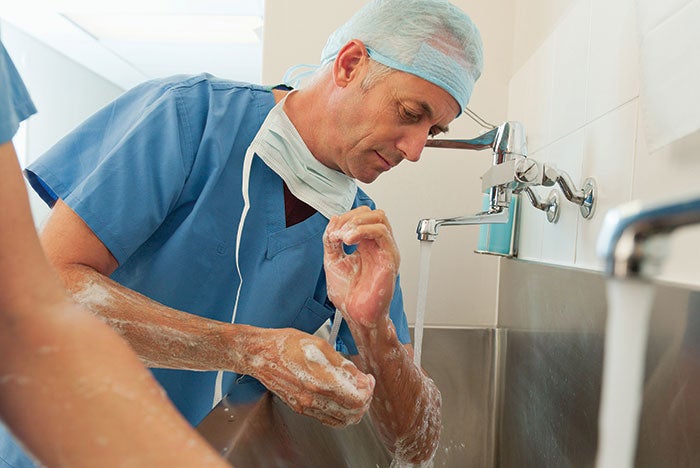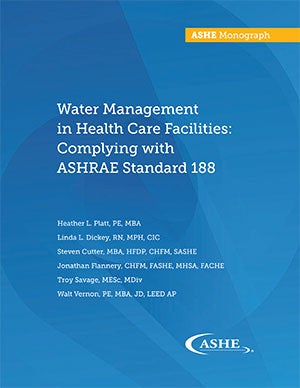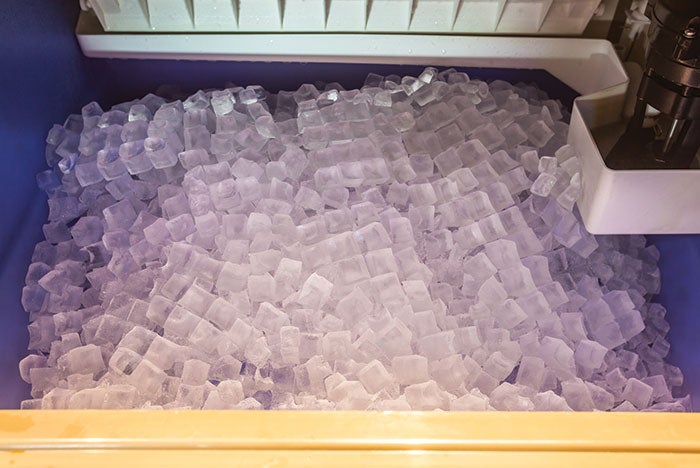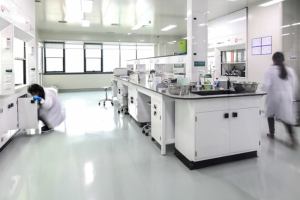Minimizing facility water system risks

The purpose of a water risk-management plan is to ensure that a health facility’s water system is safe, functional and reliable.
The ASHRAE Standard 188-2015, Legionellosis: Risk Management for Building Water Systems, establishes minimum legionellosis risk-management requirements for building water systems in all types of buildings.
However, the standard also recognizes the unique nature of health care facilities that have infection preventionists on staff, and allows qualified health care facilities to use a more risk-based approach instead of the prescriptive approach of the general ASHRAE 188 requirements.
Hospitals that are appropriately accredited by an approved accrediting organization and that have an infection prevention-control program with a certified infection preventionist or epidemiologist can choose to either comply with the general requirements or with Normative Annex A Health Care Facilities requirements.
While the main section general requirements and health care annex have similar requirements, in some instances the annex language is more focused on risk management. This article, based on a new ASHE monograph on water management [see resource box below], outlines considerations for health care facility water risk-management plans.
ASHE Resource

American Society for Healthcare Engineering (ASHE) members can get a free download of the ASHE monograph on water management. The full monograph includes information on ASHRAE Standard 188, Legionellosis: Risk Management for Building Water Systems, and its Normative Annex A, including a chart showing the difference between the two approaches. The monograph also provides information on creating a water management team, mapping the water system, designing a risk-management plan and developing standard operating procedures.
Risk-management plans
Normative Annex A requires a water risk-management plan. This plan can simultaneously meet ASHRAE 188 requirements and the Conditions of Participation from the Centers for Medicare & Medicaid Services (CMS). Several CMS requirements are related to waterborne pathogens and to providing a sanitary environment to avoid sources and transmission of infections and communicable diseases per §482.42.
Ultimately, the purpose of the water risk-management plan is to ensure that the water system is safe, functional and reliable.
The plan to minimize risk helps to prevent and control pathogenic agents in potable water by ensuring that all existing systems are properly maintained and by having a robust, water system program in place.
Hospitals should take special care when repairs, renovations, additions or alterations affect the water system.
Hospitals also should set stringent standards for how disruptions to the water system are conducted and include specific instructions for how to shut down, disinfect, test and commission the water system after it has been disturbed prior to putting the system back in use. Special care also must be taken whenever the water system is not fully used.
Health facilities professionals should pay particular attention to several areas:
Start-up and shutdown. When a building water system or portion thereof is in a no-flow condition, the opportunity for pathogen amplification is increased as the disinfection levels are depleted. Hospitals should create written procedures that outline the steps to be taken whenever an idled system is placed back in service.
Flushing each section of the piping system and connected devices is the most important component of these procedures. Periodic flushing while the system is idle will refresh the disinfectant levels and help to mitigate the amplification risk.
Maintenance and monitoring. Maintenance and monitoring procedures of water systems should include regular inspections for water-containing system components; regular flushing or mixing of known stagnant areas; and cleaning, disinfection, replacement and maintenance of water system components per the manufacturers’ recommendations.
Equipment that requires maintenance and monitoring includes hot water- and cold water-storage tanks, ice machines, water-hammer arrestors, expansion tanks, water filters, shower heads and hoses, electronic faucets, aerators, faucet flow restrictors, nonsteam aerosol-generating humidifiers, water heaters and other equipment.
Instructions and logs for maintenance must be easily accessible. Manufacturers’ recommendations should be used until evidence-based changes are warranted. Water filters should be changed regularly, because they can potentially foster pathogen growth. In addition, carbon-based filters will quickly deplete chlorine-based disinfectant levels and their use should be carefully considered and monitored.
Pathogen growth will be more prevalent in areas where water has the opportunity to stagnate and especially where recirculation is not provided. This includes areas where water flow can stop for an extended period of time because of low usage rates, such as with showers and some faucets.
Finally, facilities professionals should consider evaluating the components within the water system, such as the locations and risk of water-hammer arrestors or expansion tanks, as both of these components potentially can create locations where water can stagnate for an extended period. Filters under sinks that are used for rinsing medical devices in endoscope cleaning areas may require mechanisms to routinely rinse the particulate filters.
As adequate maintenance is performed, maintenance activities must be documented and analyzed. This is important to meet accrediting organization requirements. This documentation is part of utility management requirements, and analysis of the documentation allows verification and validation of the water risk-management plan.
Treatment. Treatment can be an important component of building procedures for potable water systems. The water system treatment procedures should identify monitoring methods and the schedule for temperature measurement in both the hot- and cold-water systems, as well as monitoring methods and the schedule for disinfection and procedures to address treatment should an outbreak occur.
Additionally, the water treatment products and procedures for use in accordance with applicable regulations should be specified for each method.
Dead legs, dead ends and water age. In general, locations where water is stagnant are dangerous for water systems because stagnant water will encourage biofilm and pathogen growth. Water that is constantly moving is less likely to develop pathogen contaminants. Water age, or the length of time it takes water to travel through a water system, should be evaluated to see that it is managed efficiently.
The greater the water age within a system, the higher the risk for development of waterborne pathogens. Therefore, care should be taken to eliminate or properly inspect and maintain all places where water may be stagnant. An evaluation of the water system should identify all locations with potential stagnant water so that every effort can be made to eliminate the risk.
Areas of particular concern are dead legs and dead ends. Dead legs are portions of a water system leading to an outlet that is either unused or rarely used. Dead ends are lengths of pipe that are closed at one end to prevent water flow. Since dead legs and dead ends result in water stagnation, water systems should be designed to eliminate these potential problem areas.
This means that all newly proposed construction and renovation should be reviewed to ensure that they do not result in the creation of dead legs or dead ends within the system. Identified dead ends and dead legs should be evaluated, and a removal plan, flushing procedure or means of recirculation should be established to eliminate these situations.
Along the same lines, consideration should be made for water storage, because storing water creates a standing, stagnant water situation. Efforts should be made to create a pumped loop, keeping the water circulating within the tank.
Dormant line and post-disturbance policy and procedures. Dormant lines may present a problem as the dormant line could encourage pathogen growth. If a dormant line is reactivated, pathogens quickly spread to the entire system. Therefore, it is critical that hospitals establish a procedure to identify dormant lines and outline clear protocols for the inspection and disinfection of these lines prior to their being placed back into service.
If an area of the hospital (for example, a unit or a floor) becomes unoccupied, systems must be in place to ensure that the water system is periodically flushed and that specific start-up procedures are followed prior to reoccupying the area.
Hot- and cold-water systems. Hot-water systems are particularly important to monitor because they can operate at temperatures that encourage Legionella and other pathogen growth. Legionella can multiply in water between 68 F and 122 F (20-50 C), with temperatures between 77 F and 108 F (25-42 C) providing ideal growth conditions. Even hot-water systems with initial settings above 122 F
(50 C) may have sections where water is in the temperature range that encourages Legionella multiplication.

Maintenance and monitoring procedures of water systems should include regular inspections for water-containing system components such as ice machines.
Proper design standards and routine maintenance should be followed to reduce the risk of pathogen growth. The systems in higher-risk areas should be evaluated on a regular interval, correlating evaluation with times of highest risk.
Temperatures and chemical residual should be checked regularly. Maintenance should be conducted carefully and in accordance with schedules to help ensure adequacy. Proper design and maintenance should be coupled with diligent monitoring of health care-associated infections (HAIs) so that timely corrective actions can be instituted.
Similarly, cold-water systems should be kept cold enough to discourage pathogen growth. For Legionella, care must be taken because a cold-water system with an initial setting below 60 F (20 C) may have sections where the water rises to the temperature range required for Legionella multiplication. Temperature should be checked regularly and at different system locations to ensure that it is kept sufficiently low.
Additionally, consideration should be given to implementing design standards that reduce potential hazards. Select piping with minimal adhesiveness wherever possible to reduce biofilm growth, and eliminate deficiencies in the system such as cross-connections. The use of automatic flushing devices can decrease the risk of biofilm development and pathogen growth and should be considered for use within high-risk areas.
Drainage. Hospitals have thousands of shower heads, and if they are not self-draining, they could present locations for pathogen growth. Health care facilities may consider enacting a policy requiring all shower heads to be self-draining or, for those shower heads that do not meet this requirement, a policy that they be evaluated and potentially replaced as soon as possible.
More stringent requirements may be necessary for protective environment units. In areas with high-risk patient populations, consider removing the shower hooks that prevent the flexible handheld shower hoses from draining. This will allow the hose to hang down and drain properly.
Equipment selection. Equipment selection is an important factor in reducing waterborne pathogen risk, although selection requires deciding among many competing interests. For example, some plumbing fixtures that reduce flow rates also may trap water within the fixture or create flows so low that pathogen risk increases.
Oversizing water pipes can lead to low-flow situations throughout the building. Therefore, when selecting system components, system efficiency and patient risk must be considered.
The use of aerators and flow restrictors in faucets also has been a contentious debate. Some suspect that aerators represent a location of potential pathogen growth associated with HAIs, but have not been able to produce documentation proving these suspicions.
Some people believe that splashing at hand-washing stations could transmit bacteria to the water system through the faucets and that aerators enhance the potential risk. Flow restrictors should not be allowed to restrict the flow to less than 1.5 gallons per minute.
Cooling towers and evaporative condensers. Cooling towers represent a particular risk for legionellosis and other waterborne pathogens, and specific care needs to be taken in properly maintaining them. The water risk-management plan documents should identify the person responsible for ensuring that maintenance is performed.
The pH and chlorine levels in each active tower should be tested regularly. Active towers should be inspected weekly and inactive towers should be drained.
ASHRAE 188 requires the water risk-management plan to identify specific requirements for system maintenance, water treatment, shutdown and start-up, disinfection of the cooling towers and evaporative condensers, and the location of the cooling tower makeup valve.
Water features. Special care must be taken for water features that are particularly susceptible to pathogenic agents. They include fountains, therapy pools and therapy spas. Proper maintenance and chemical treatment will reduce and potentially mitigate the risk of waterborne pathogen aerosolizing.
The patient population should be taken into account when considering the location of such features. The water risk-management plan should include specific testing requirements and acceptable chemical levels, and clearly identify chemicals used. If a chemical treatment is changed, be sure to update the water risk-management plan to reflect this.
Policies and procedures for maintaining water features that follow manufacturers’ recommendations should be developed and followed. These procedures typically include draining, cleaning all components, and disinfecting and refilling the water feature.
Recirculating pumps should be provided and confirmed to be running. Submerged lights should not operate unless the recirculating pump is active. In addition, proper maintenance includes cleaning visible buildup of dirt, organic matter and other debris.
Disinfection of equipment components and replacement of water in systems with low volume (less than 5 gallons) should be a component of the plan for managing water features. For features with volumes of water greater than 5 gallons, disinfection in accordance with the manufacturer’s recommendation is required.
Finally, ASHRAE 188 explicitly states that pools and spas shall be operated and maintained in accordance with the original equipment manufacturer’s requirements.
Biomedical equipment. Several pieces of biomedical equipment (e.g., for dialysis or heart-lung machines) use water for specific processes and procedures. This equipment may rely upon regular, deionized or even reverse-osmosis water.
Proper understanding of procedures for this type of equipment use and cleaning should be documented and reviewed for compliance. The intent is to ensure that there is no standing water in the equipment.
Areas to watch
While the flexibility of ASHRAE 188 Annex A allows health facilities professionals to tailor a risk-based program to their specific needs, it also requires them to pay particular attention to specific parts of their water systems.
The water system elements featured in this article are some of the key areas to watch.
[This article originally appeared in the Spring 2017 edition of Inside ASHE, © American Society for Healthcare Engineering 2017 and is reprinted with permission.]
Jonathan Flannery, CHFM, FASHE, MHSA, FACHE, is senior associate director of advocacy for the American Society for Healthcare Engineering. He can be reached at jflannery@aha.org.




